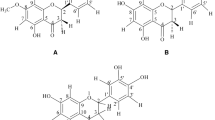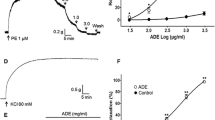Abstract
Previous studies have investigated the cardiovascular activity of Gynura procumbens Merr. single-solvent extracts. The objective of this study was to evaluate the in vitro vasorelaxant properties and the underlying pharmacological mechanisms of serial extracts and fractions of Gynura procumbens (GP). The leaves of GP were serially extracted with petroleum ether, chloroform, methanol and water using the maceration method. Suspended aortic ring preparations were pre-contracted with phenylephrine (PE 1 µM), followed by cumulative addition of GP extracts (0.25–3 mg/mL). The petroleum ether extract (GPPE) was the most potent among the four extracts. Pre-incubation of endothelium-intact aorta with atropine (1 µM), indomethacin (10 µM), methylene blue (10 µM), propranolol (1 µM) and potassium channel blockers such as TEA (1 µM), glibenclamide (10 µM), 4-aminopyridine (1 µM) and barium chloride (10 mM) had no effect on GPPE-induced vasorelaxation. The vasorelaxant effect of GPPE was partly diminished by pretreatment of aortic rings preparations with l-NAME (10 µM) and even more so in endothelium-denuded aortic rings, indicating a minimal involvement of endothelium-dependent pathway in GPPE-induced vasorelaxation. The calcium-induced vasocontractions were antagonized significantly and concentration-dependently by GPPE in calcium free and high potassium medium. These results illustrate that Ca2+ antagonizing actions of GPPE in rat isolated aorta are comparable to that of verapamil and may be mainly responsible for its vasodilation effect. The antioxidant activity of GPPE supports its vasorelaxant effect by attenuating the production of deleterious free radicals and reactive oxygen species in the vasculature.








Similar content being viewed by others
References
Abrika OSS et al (2013) Effects of extracts and fractions of Gynura procumbens on rat atrial contraction. J Acupunct Meridian Stud 6:199–207
Ajay M, Gilani AU, Mustafa MR (2003) Effects of flavonoids on vascular smooth muscle of the isolated rat thoracic aorta. Life Sci 74:603–612
Akowuah G, Sadikun A, Mariam A (2002) Flavonoid identification and hypoglycaemic studies of the butanol fraction from Gynura procumbens. Pharm Biol 40:405–410
Akpuaka A, Ekwenchi MM, Dashak DA, Dildar A (2013) Biological activities of characterized isolates of n-Hexane extract of Azadirachta Indica A.Juss (Neem) leaves. Nat Sci 11(5):141–147
Akter K et al (2016) Phytochemical profile and antibacterial and antioxidant activities of medicinal plants used by aboriginal people of New South Wales, Australia. Evid Based Complement Altern Med eCAM 2016:4683059
Alok P, Suneetha V (2014) Punica granatum (Pomegranate) rind extract as a potent substitute for LAscorbic acid with respect to the antioxidant activity. RJPBCS 5:597
Ameer OZ et al (2010) Pharmacological mechanisms underlying the vascular activities of Loranthus ferrugineus Roxb. in rat thoracic aorta. J Ethnopharmacol 127:19–25
Awad AB, Chan KC, Downie AC, Fink CS (2000) Peanuts as a source of beta-sitosterol, a sterol with anticancer properties. Nutrition Cancer 36:238–241
Bello I, Usman NS, Mahmud R, Asmawi MZ (2015) Mechanisms underlying the antihypertensive effect of Alstonia scholaris. J Ethnopharmacol 175:422–431
Benzi G, Ceci A (1997) Herbal medicines in European regulation. Pharm Res 35:355–362
Benzie IF, Strain J (1996) The ferric reducing ability of plasma (FRAP) as a measure of “antioxidant power”: the FRAP assay. Anal Biochem 239:70–76
Bohari M et al (2006) Glucose uptake: stimulatory activity of Gynura procumbens in 3T3-F442A adipocytes, Malaysian medicinal plant: chemistry and biological activity. UNIMAS and Malaysian Natural Products Society, Sarawak
Boshtam M, Rafiei M, Sadeghi K, Sarraf-Zadegan N (2002) Vitamin E can reduce blood pressure in mild hypertensives. Int J Vitam Nutr Res 72:309–314
De Reuck J (2010) Stroke characteristics in patients with pretreated arterial hypertension. Eur Neurol 64:355–359
Elena S, Kagan V, Han D, Packer L (1991) Free radical recycling and intramembrane mobility in the antioxidant properties of alpha-tocopherol and alpha-tocotrienol. Free Radical Biol Med 10:263–275
Fukumura D et al (2001) Predominant role of endothelial nitric oxide synthase in vascular endothelial growth factor-induced angiogenesis and vascular permeability. Proc Natl Acad Sci 98:2604–2609
Fuster V, Kelly BB (2010) Promoting cardiovascular health in the developing world: a critical challenge to achieve global health. National Academies Press, Washington
Guedes DN, Silva D, Barbosa-Filho J, De Medeiros IA (2004) Endothelium-dependent hypotensive and vasorelaxant effects of the essential oil from aerial parts of Menthax villosa in rats. Phytomedicine 11:490–497
Herrmann F, Lindemann A, Gauss J, Mertelsmann R (1990) Cytokine-stimulation of prostaglandin synthesis from endogenous and exogenous arachidonic acids in polymorphonuclear leukocytes involving activation and new synthesis of cyclooxygenase. Eur J Immunol 20:2513–2516
Hoe SZ, Kamaruddin MY, Lam SK (2007) Inhibition of angiotensin-converting enzyme activity by a partially purified fraction of Gynura procumbens in spontaneously hypertensive rats. Med Princ Pract Int J Kuwait Univ Health Sci Cent 16:203–208
Hoe SZ et al (2011) Gynura procumbens Merr. decreases blood pressure in rats by vasodilatation via inhibition of calcium channels. Clinics 66:143–150
Idris B et al (2015) Antihypertensive and vasorelaxant effect of Alstonia scholaris stem bark extracts and fractions. Int J Pharmacol 11:327–334
Jiratchariyakul W et al (2000) Antiherpes simplex viral compounds from Gynura procumbens Merr. Mahidol University Annual Research, Salaya
Kaliyan B et al (2016) Chemical analysis of Punica granatum fruit peel and its in vitro and in vivo biological properties. BMC Complementary Alternative Med 16:264
Kannan A, Janardhanan R (2014) Hypertension as a risk factor for heart failure. Curr Hypertens Rep 16:447
Karaki H et al (1997) Calcium movements, distribution, and functions in smooth muscle. Pharmacol Rev 49:157–230
Karunamoorthy K et al (2011) Chemical composition, antimicrobial, antioxidant and anticancer activity of leaves of Syzygium benthamianum (Wight ex Duthie) gamble. JBAPN 1:273–278
Kaur N et al (2012) Cardio-vascular activity of Gynura procumbens Merr. leaf extracts. Int J Pharm Sci Res 3:1393
Kaur N et al (2013) Antihypertensive effect of Gynura procumbens water extract in spontaneously hypertensive rats. Int J Appl Res Nat Prod 6:20–27
Keng CL, Yee LS, Pin PL (2009) Micropropagation of Gynura procumbens (Lour.) Merr. an important medicinal plant. J Med Plants Res 3:105–111
Kim MJ, Lee HJ, Wiryowidagdo S, Kim HK (2006) Antihypertensive effects of Gynura procumbens extract in spontaneously hypertensive rats. J Med Food 9:587–590
Kumaran A, Karunakaran RJ (2006) Antioxidant and free radical scavenging activity of an aqueous extract of Coleus aromaticus. Food Chem 97:109–114
Kumari STK, Muthukumarasamy S, Mohan VR (2012) GC-MS analysis of ethanol extract of sarcostemma secamone (l) bennet (asclepiadaceae). Sci Res Reporter 2:187–191
Lackland DT, Voeks JH, Boan AD (2016) Hypertension and stroke: an appraisal of the evidence and implications for clinical management. Expert Rev Cardiovasc Ther 14:609–616
Loizou S, Lekakis I, Chrousos GP, Moutsatsou P (2010) β-Sitosterol exhibits anti-inflammatory activity in human aortic endothelial cells. Mol Nutrition Food Res 54:551–558
Luna-Vázquez FJ et al (2016) Role of nitric oxide and hydrogen sulfide in the vasodilator effect of ursolic acid and uvaol from black cherry Prunus serotina fruits. Molecules 21:78
Maione F et al (2013) Phenols, alkaloids and terpenes from medicinal plants with antihypertensive and vasorelaxant activities. A review of natural products as leads to potential therapeutic agents. Nat Prod Commun 8:539–544
Mallikadevi TSP, Jamuna S, Karthikka K (2012) Analysis for phytoceuticals and bioinformatics approach for the evaluation of therapetic properties of whole plant methanolic extract of Mukia maderaspatana (l.) m.Roem. (cucurbitaceae)—a traditional medicinal plant in western districts of Tamil Nadu, India. Asian J Pharm Clin Res 5(4):163–168
Maxwell SR, Lip GY (1997) Free radicals and antioxidants in cardiovascular disease. Br J Clin Pharmacol 44:307–317
Meisheri KD, Hwang O, van Breemen C (1981) Evidence for two separate Ca2+ pathways in smooth muscle plasmalemma. J Membr Biol 59:19–25
Orhan N, Orhan IE, Ergun F (2011) Insights into cholinesterase inhibitory and antioxidant activities of five Juniperus species. Food Chem Toxicol 49:2305–2312
Perez-Hernandez N et al (2009) Structure–activity relationships of aromadendranes in uterus-relaxant activity. Zeitschrift fur Naturforschung C J Biosci 64:840–846
Re R et al (1999) Antioxidant activity applying an improved ABTS radical cation decolorization assay. Free Radic Biol Med 26:1231–1237
Samuel ES et al (2012) Antihypertensive effect of Lepechinia caulescens extract on spontaneously hypertensive rats. Phytopharmacology 2:170–178
Sheela D, Uthayakumari F (2013) GC-MS analysis of bioactive constituents from coastal sand dune taxon–sesuvium portulacastrum (l.). Biosci Discovery 4: 47–53
Somlyo AP, Somlyo AV (1994) Signal transduction and regulation in smooth muscle. Nature 372:231–236
Tan JBL, Lim YY (2015) Critical analysis of current methods for assessing the in vitro antioxidant and antibacterial activity of plant extracts. Food Chem 172:814–822
Thorneloe KS, Nelson MT (2005) Ion channels in smooth muscle: regulators of intracellular calcium and contractility. Can J Physiol Pharmacol 83:215–242
Tibiriçá E et al (2007) Pharmacological mechanisms involved in the vasodilator effects of extracts from Echinodorus grandiflorus. J Ethnopharmacol 111:50–55
Wang K-J, Yang C-R, Zhang Y-J (2007) Phenolic antioxidants from Chinese toon (fresh young leaves and shoots of Toona sinensis). Food Chem 101:365–371
WHO (1998) Guidelines for the appropriate use of herbal medicines, WHO. WHO Regional Publications. Western Pacific Series; No. 23, p 88
Xiong Z, Sperelakis N (1995) Regulation of L-type calcium channels of vascular smooth muscle cells. J Mol Cell Cardiol 27:75–91
Zhang B, Qiu L, Fu M, Hu S (2012) Interference in mevalonate pathway ameliorates homocysteine-induced endothelium-dysfunction. Eur J Pharmacol 692:61–68
Acknowledgements
This research was funded by the Malaysian Ministry of High Education (MOHE) with a grant provided to Professor Mohd Zaini Bin Asmawi (Grant no. 203/PFARMASI/6711451). We thank Mr. Roseli Hassan and Mr. Selva for their kind assistance during this study. We also acknowledge the Institute of Postgraduate Studies (IPS), USM, Penang, Malaysia, for the USM fellowship award to the first author, Ref. P-FD0019/12(R).
Author information
Authors and Affiliations
Corresponding authors
Rights and permissions
About this article
Cite this article
Iqbal, Z., Bello, I., Asmawi, M.Z. et al. Vasorelaxant activities and the underlying pharmacological mechanisms of Gynura procumbens Merr. leaf extracts on rat thoracic aorta. Inflammopharmacol 27, 421–431 (2019). https://doi.org/10.1007/s10787-017-0422-4
Received:
Accepted:
Published:
Issue Date:
DOI: https://doi.org/10.1007/s10787-017-0422-4




